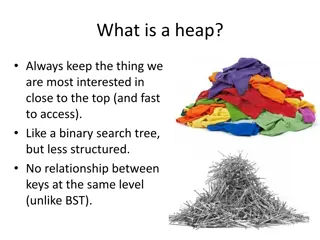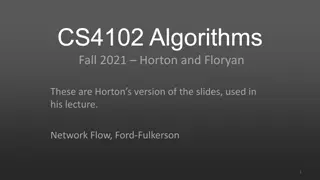Understanding Max Flow in Network Theory
In network theory, understanding the concept of maximum flow is crucial. From finding paths to pushing flow along edges, every step contributes to maximizing the flow from a source to a target in the graph. The process involves determining capacities, creating flows, and calculating the net flow entering and leaving a vertex. By following these principles, finding the maximum flow in a network becomes an achievable task, guiding the efficient movement of commodities like water or data packets.
Download Presentation

Please find below an Image/Link to download the presentation.
The content on the website is provided AS IS for your information and personal use only. It may not be sold, licensed, or shared on other websites without obtaining consent from the author. Download presentation by click this link. If you encounter any issues during the download, it is possible that the publisher has removed the file from their server.
E N D
Presentation Transcript
Network Flow CSE 417 Winter 21 Lecutre 19
Announcements HW4 solutions on webpage HW5 (written part) still due tonight Remember you have the extra late days HW6 comes out tonight. Due in 2 weeks. Finish up HW5 programming Question 2 (finding a max flow and min cut) will make sense tonight Question 3 will make sense Monday Questions 4-5 will make sense Wednesday
Max Flow We have a directed graph ?, a source vertex ? and a target vertex ?. We have some commodity (water or data packets) we have to send from ? to ?. Every edge has a capacity, it can only handle so much water. 2 ? 4 1 ? 2 ? 2 ? 1 1 5 4 ? ? ? 1
Flows A flow flow moves units of water from ? to Water can only be created at ? and only disappear at ?. And you cannot move more water than the capacity on any edge. to ?. 2 ? 4 1 ? 2 ? 2 ? 1 1 5 4 ? ? ? 1
Flows A flow flow moves units of water from ? to Water can only be created at ? and only disappear at ?. And you cannot move more water than the capacity on any edge. to ?. 2/2 ? 3/4 1/1 ? 2/2 ? 0/2 ? 1/1 1/1 2/5 2/4 ? ? ? 1/1
Flows The value value or size Or, equivalently the net flow entering ?. size of a flow is the net flow leaving ? Value of this flow is 5. 2/2 ? 3/4 1/1 ? 2/2 ? 0/2 ? 1/1 1/1 2/5 2/4 ? ? ? 1/1
Finding the Max Flow Idea: find a path that we can push flow along. Start from ?, follow an edge with remaining capacity until you get to ? How much flow can you add? The minimum remaining of the edges we used. Does this work? remaining capacity on any 0/10 0/20 0/20 s t 0/10 0/20
Finding the Max Flow Idea: find a path that we can push flow along. Start from ?, follow an edge with remaining capacity until you get to ? How much flow can you add? The minimum remaining of the edges we used. Does this work? remaining capacity on any 0/10 0/20 0/20 s t 0/10 0/20
Finding the Max Flow Idea: find a path that we can push flow along. Start from ?, follow an edge with remaining capacity until you get to ? How much flow can you add? The minimum remaining of the edges we used. Does this work? remaining capacity on any 0/10 20/20 20/20 s t 0/10 20/20
Finding the Max Flow Idea: find a path that we can push flow along. Start from ?, follow an edge with remaining capacity until you get to ? How much flow can you add? The minimum remaining of the edges we used. Does this work? remaining capacity on any 0/10 20/20 20/20 s t 0/10 20/20
Finding the Max Flow We find a valid flow but it might not be the maximum one. What our first idea found The true optimum 10/10 0/10 20/20 20/20 10/20 s 20/20 s t t 10/10 0/10 20/20 20/20
Finding the Max Flow How would we fix what our first idea found? What our first idea found The true optimum 10/10 0/10 20/20 20/20 10/20 s 20/20 s t t 10/10 0/10 20/20 20/20
Finding the Max Flow How would we fix what our idea found? What our first idea found The true optimum 10/10 0/10 20/20 20/20 10/20 s 20/20 s t t 10/10 0/10 20/20 20/20 We can send extra flow from ? and decrease the flow along another edge with existing flow And we ll still get a valid flow!
Finding the Max Flow How would we fix what our first idea found? What our first idea found The true optimum 10/10 0/10 20/20 20/20 10/20 s 20/20 s t t 10/10 0/10 20/20 20/20
Fixing Our First Idea When can we send flow in a direction? When there is unused capacity OR When there is flow going the other direction we can delete it. Let s update the graph to take that into account. Have an edge weight demonstrate the changeable capacity (the residual )
An Example Graph, with flow Residual Graph 0/10 10 0/20 20 0/20 s 20 s t t 0/10 10 0/20 20 0/10 10 20/20 20 20/20 s 20 s t t 0/10 10 20/20 20
An Example Graph, with flow Residual Graph 0/10 10 20/20 20 20/20 s 20 s t t 0/10 10 20/20 20 10/10 10 20/20 20 10/20 s s t t 10 10 10/10 10 20/20 20
Residual Graph In general: If the original graph has an edge (?,?) of capacity ?, and the flow sends ??,? along (?,?): Include (?,?) in the residual with capacity ? ??,? as long as ? ??,?> 0 (if equal to zero, don t include the edge) Include (?,?) [the edge going in the reverse direction] with capacity ??,? as long as ??,?> 0
Ford-Fulkerson Algorithm While(flow is not maximum) Run BFS in residual graph starting from ?. Record predecessors to find an ?,?-path Iterate through path, finding ? minimum residual capacity on path. Add ? to every edge on path in flow Update residual graph
Ford-Fulkerson Algorithm While(true) Running Time:? ?(?) per iteration. Number of iterations? Run BFS in residual graph starting from ?. Record predecessors to find an ?,?-path If you don t reach ?, break. //otherwise you can still augment Iterate through path, finding ? minimum residual capacity on path. Add ? to every edge on path in flow Update residual graph Assuming ? ?(isolated vertices won t affect the flow, so this is reasonable).
Ford-Fulkerson Algorithm If we have all integer capacities at the start... The residual graph will always have integer capacities. Why? The minimum capacity on the first path is an integer. So we subtract or add integers to the residual graph. And the result is more integers! So in every iteration we add at least 1 unit of flow!
Ford-Fulkerson Algorithm While(true) Running Time:? ?(?) per iteration. Number of iterations? ?(?), where ? is the value of the maximum flow. Total ?(??) Run BFS in residual graph starting from ?. Record predecessors to find an ?,?-path If you don t reach ?, break. //otherwise you can still augment Iterate through path, finding ? minimum residual capacity on path. Add ? to every edge on path in flow Update residual graph
Wait?? We haven t seen a running time before that depends on the answer answer Normally, we want the running time directly in terms of the input. There are tricks to speed up Ford-Fulkerson so you don t take too long if ? is really big. Some optional content about this at the end of this deck.
Remember cuts? We talked about them a long time ago, when we were defining safe edges for MST algorithms. That was for undirected graphs. For this problem: An (?,?)-cut, is a split of the vertices into two sets (?,?) So that ? is in ?, ? is in ?, and every other vertex is in exactly one of ? and ?. The capacity of a cut (or size of a cut) is the capacity of the edges going from ? to ?(don t count capacity from ? to ?).
An Example Graph, with flow Residual Graph 10 10/10 20 20/20 10/20 s s t t 10 10 10 10/10 20 20/20 We can t get from ? to ? anymore in the residual graph. We re done! That s a maximum flow. But why?
An Example Graph, with flow Residual Graph 10 10/10 20 20/20 10/20 s s t t 10 10 10 10/10 20 20/20 Cut is (?, ? ?) (i.e. ? on one side, everything else on the other) Edges from ? to everything else? Capacity 30 We can t get more than 30 units of flow from ? to ?. Because it all (simultaneously) must cross from one side to the other.
How Do We Know? How do we know the algorithm is done? When we can t we get from ? to ?? We ve cut ? and all the vertices you can reach from it on one side and ? and all the vertices ?can t reach on the other. cut the (residual) graph. Take a look at the edges spanning the cut in the original graph. In our first graph, that capacity was equal to the value of the max flow. .
Finding the min-cut Maintain the residual graph. When you search from ?and can t get to ?: ? and everything you can reach from ? is on one side of the cut ?and everything you can t reach from ? is on the other side.
Another Example We started lecture with this flow. What s the residual graph? What s the residual graph? What s the cut? 2/2 ? 3/4 1/1 ? 2/2 ? 0/2 ? 1/1 1/1 2/5 2/4 ? ? ? 1/1
Another Example We started lecture with this flow. What s the residual graph? What s the residual graph? What s the cut? 2/2 ? 3/4 1/1 ? 2/2 ? 0/2 ? 1/1 1/1 2/5 2/4 ? ? ? 1/1
Another Example ? Residual ? ? ? ? ? ? Flow 2/2 ? 3/4 1/1 ? 2/2 ? 0/2 ? 1/1 1/1 2/5 2/4 ? ? ? 1/1
Another Example 2/2 ? 3/4 1/1 ? 2/2 ? 0/2 ? 1/1 1/1 2/5 2/4 ? ? ? 1/1 ?,?,?,? , ?,?,? is the cut in the residual graph. What edges span? ?,? , ?,? , ?,? ,(?,?) Total capacity? 5. What s the value of the flow? 5
Max Flow-Min Cut Theorem Max-Flow-Min-Cut Theorem The value of the maximum flow from ? to ? is equal to the value of the minimum cut separating ? and ?. No proof, but here s some intuition: Every cut is an upper-bound on the value of the flow (you can t have the total flow value higher than the cut). Cut will be saturated (i.e. full flow going through all the edges) otherwise residual graph will have another edge. So flow and cut are equal values.
So What? Max-flow and min-cut are each interesting algorithmic problems. They were first studied in the 1950s The U.S. military wanted to know how much the Soviets could ship on their rail network. And also which rail lines they would target to disrupt the network.
So What? Great quick check for if you ve found the maximum flow (or min-cut). Check the other and see if the value is the same! We ll see examples next time of max-flow used for modeling. In those cases the min-cut can be interpreted as a barrier to a good assignment. It s also a nice example of duality If you know what a dual linear program is flows and cuts are dual LPs. duality
Write an LP for finding the biggest flow Let ? ? be the capacity on edge ?
Write an LP for finding the biggest flow Let ? ? be the capacity on edge ? Max ?:? enters ??? Subject to: ?:? enters ???= ?:? leaves ??? for every ? other than ? and ? 0 ?? ?(?) for every edge ?
Speeding Up Ford-Fulkerson Ford-Fulkerson is only slow if ? is big and we keep doing very small updates. If instead of finding any any ?,? path you find a particular one (the one with the fewest edges, or the one that will lead to the biggest increase) you can guarantee you ll do fewer iterations. Each iteration will take a little longer to find the good path, but the tradeoff is often worth it. In particular some algorithms end up with running times independent of ?. In practice, Ford-Fulkerson is usually fine! The fastest-known (theoretically) is Orlin s algorithm: running time ? ?? .























